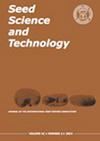Comparison of the effects of three priming agents in enhancing the chilling tolerance of tobacco seeds during germination
IF 3
4区 农林科学
Q2 AGRONOMY
引用次数: 0
Abstract
Early spring low temperature hazards are a common problem in southern China’s tobacco production areas, leading to slow germination of tobacco seeds. In the present study, spermine (Spm), salicylic acid (SA) and polyethylene glycol (PEG) were used to prime seeds of different tobacco cultivars. After priming, their germination indices were evaluated in an optimal temperature (25°C) germination test and a low temperature (12°C) germination test. In the optimal temperature germination experiment, priming with any of Spm, SA and PEG could improve the germination index (GI) and reduce the mean germination time (MGT) of ‘Xiangyang No. 7’ seeds. Moreover, priming with Spm or PEG enhanced the vigour indices (VI) at most priming concentrations and durations, while SA priming with 0.5 mmol L-1 for 24 hours improved the germination potential (GE) and SA priming with 0.5 and 0.6 mmol L-1 for 48 hours improved germination potential (GP). For the low temperature germination experiment, Spm or PEG priming treatment based on the optimal temperature germination experiment markedly improved GI and VI, which was confirmed by the enhancement of antioxidative enzyme activities, while the selected SA priming treatments significantly enhanced GI except for at 0.6 mmol L-1 for 12 hours. Our results indicated that Spm, SA and PEG could be used for enhancing chilling tolerance of tobacco seeds and improving seed germination.三种起爆剂提高烟草种子萌发耐冷性的效果比较
早春低温危害是中国南方烟草产区普遍存在的问题,导致烟草种子发芽缓慢。本研究采用精胺(Spm)、水杨酸(SA)和聚乙二醇(PEG)对不同烟草品种的种子进行了引种。启动后,通过最适温度(25°C)和低温(12°C)萌发试验评价其萌发指标。在最适萌发温度试验中,施用Spm、SA和PEG均可提高‘向阳7号’种子的萌发指数(GI),缩短平均萌发时间(MGT)。此外,Spm和PEG在大多数浓度和持续时间下都能提高幼苗的活力指数(VI), 0.5 mmol L-1 SA处理24 h能提高萌发势(GE), 0.5和0.6 mmol L-1 SA处理48 h能提高萌发势(GP)。在低温萌发试验中,在最适温度萌发试验基础上,Spm和PEG处理显著提高了GI和VI,这可以通过增强抗氧化酶活性来证实,而选择的SA处理除0.6 mmol L-1处理12 h外,显著提高了GI。结果表明,Spm、SA和PEG可以提高烟草种子的耐冷性,促进种子萌发。
本文章由计算机程序翻译,如有差异,请以英文原文为准。
求助全文
约1分钟内获得全文
求助全文
来源期刊

Seed Science and Technology
农林科学-农艺学
CiteScore
3.00
自引率
28.60%
发文量
36
审稿时长
>36 weeks
期刊介绍:
Seed Science and Technology (SST) is an international journal featuring original papers and articles on seed quality and physiology related to seed production, harvest, processing, sampling, storage, genetic conservation, habitat regeneration, distribution and testing. A journal that meets the needs of researchers, advisers and all those involved in the improvement and technical control of seed quality. Published every April, August and December.
 求助内容:
求助内容: 应助结果提醒方式:
应助结果提醒方式:


